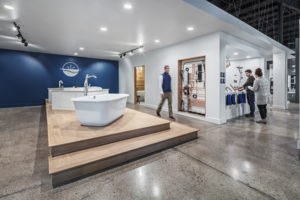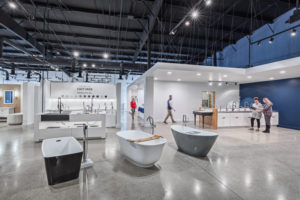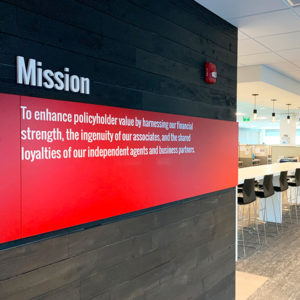Five Applications of Environmental Graphics
Immersive, effective environments are magic.
When you think of graphic design, you might think of a logo on a website or an advertisement in a magazine. But do you think about graphic design in the physical environment? Graphic design elements like words and typography, images, colors, shapes, logos, and signs can be fabricated and installed throughout a building to enhance the experience of being inside it. These installations create meaningful and engaging interactions between people and their surroundings. Immersive, effective environments are magic. WSA creates them by connecting visual communication and architecture to create an immersive, effective environment.
At WSA, we’ve pinpointed high-impact methods of integrating environmental graphics and architecture. These are the five most common ways we use environmental graphics to improve the experience of our clients’ spaces:
Wayfinding in the Built Environment
Directional signage makes a frequent appearance in everyday life. It directs people on the right path, improving traffic flow and avoiding frustrating inefficiencies. An effective wayfinding sign is one that you don’t have to think about because it feels like it’s supposed to be there. It instantly communicates information that makes life easier. This type of environmental graphic design is vital for our clients in corporate office high rises and universities, where hundreds of people navigate various departments and services daily.
We combine architecture and environmental graphics to create well-defined paths and help orient people within a space. For example, the Point at Otterbein University features a bold statement soffit with angular red points hanging over the lobby. This recognizable feature marks this space as the center of the renovated warehouse, serving as a landmark that invites energy and helps students find their way back to the center. The halls of the Point utilize frosted vinyl arrows overlaid on the glass corridor walls to guide through the building. The implicit messaging subtly moves students through their day.
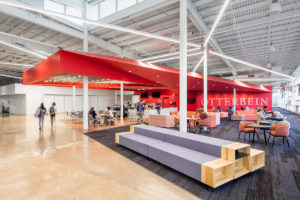
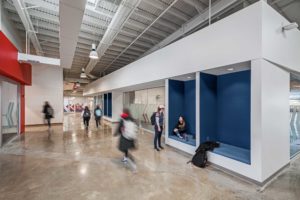
Architectural Brand Identity
This is where the traditional role of graphic design comes in. Every company should have an identifiable logo, color, and font that reflects its message. These visual symbols form immediate meanings and set expectations within a company.
While a logo is commonly seen in promotional print and digital media, it’s also important for organizations to utilize their visual brand within their physical facilities. Organizations can utilize the logo and visual standards to create a cohesive brand experience within their own facilities.
Organizational Mission and Values
Connecting people to a sense of purpose is a top priority for a healthy workplace culture. It can even speak to clients, reinforcing your message on every level of interaction. Environmental graphics can achieve this with visual representations of an organization’s mission applied throughout the workplace. In the image on the left, Encova Insurance showcases its historic rebrand with interior wall murals, drawing users into the Encova experience. The Ohio Mutual Insurance story is delivered with reinforced mission and values throughout the space (right).
When employees are more engaged with the mission and values of their company, they are more productive at work.
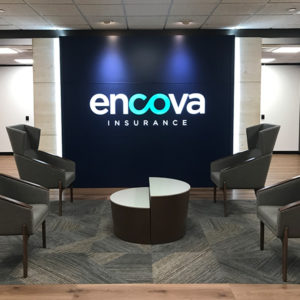
Interactive Technology
Using digital technology is a highly effective way to engage people in your space. Digital screens are versatile tools that engage users with the space by providing interactive means of communication. Videos and other media can be easily swapped for different occasions.
Interactive displays invite users to touch, watch, and listen, making them an engaging learning tool. This direct engagement remains in the memory for longer, increasing name recognition and the ability to recall information. At Otterbein University, we incorporated digital wayfinding at the entrance of the Point. A large touch screen map and directory helps guests and students easily navigate the renovated warehouse.
Product Promotion
Raise awareness of new products and services with a promotional display. The Forge showcases product prototypes in the office lobby to demonstrate the technical creation process to clients. This type of environmental graphic design allows organizations to express their selling point by showing a physical example of their work.
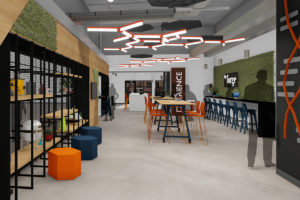
The Bathworks showroom features interactive product displays which allow customers to test working fixtures. High-end bathtubs bubble away on a raised oak platform which conceals the plumbing lines and becomes the center of the showroom. Another environmental installation highlights the Bathworks brand by framing a network of copper pipes behind the drywall. A functioning shower display invites customers to push buttons and get a first-hand feel for their at-home shower experience before purchasing. Bathworks displays its products to display trust.
